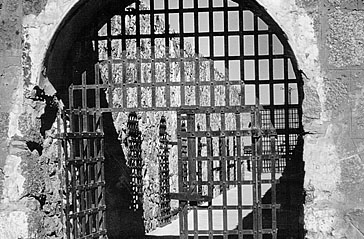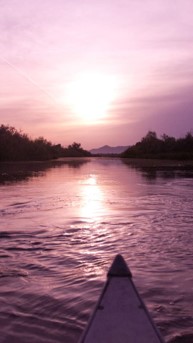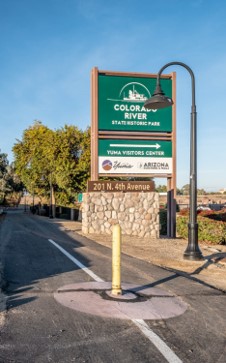
Sitting on a bluff overlooking the Colorado River, three miles west of the confluence of the Colorado and the historic Gila River, stand the ruins of Arizona’s famous Territorial Prison, and a short distance west are the remaining buildings that served as a part of the Yuma Quartermaster's Depot. Fernando de Alarcon, who accompanied Coronado on his search for the Seven Cities of Cibola, passed this site in 1540. Padre Kino saw the present location of the Prison and the Quartermaster's Depot in 1683, and Padre Graces established a mission directly across the river and was later killed there by the Indians in 1781. Yuma began to experience the American westward surge when countless immigrants crossed by ferry from Yuma on their way to the California gold fields in 1849. In 1850, a military post was established at Yuma, and when rich placer gold strikes on the Colorado River precipitated a gold rush in 1858, Yuma experienced a boom. In 1871 Yuma incorporated and became the county seat of Yuma County. The Territorial Prison was authorized by the Legislature in 1875 and $25,000 was budgeted for the project. Ground was broken on April 28, 1876, and some of the prisoners were pressed into service to build their cells. The first seven inmates moved into the facility on July 1, 1876. The Prison held a variety of law violators, including the legendary stagecoach robber Pearl Hart. The Prison continued in operation for 33 years when, due to overcrowding, all inmates were moved to a new facility in Florence, Arizona. From the date of closure, the prison's facilities have been occupied and used by various groups. After Yuma High School burned, the High School Board rented four structures and used them from 1910 until 1914. The school athletic teams became known as "The Criminals". The County Hospital utilized the facilities from 1914 until 1923. In 1924, the Southern Pacific Railroad demolished the western one-third of Prison Hill to make way for the new tracks. The Veterans of Foreign Wars leased the guard's quarters in 1931 and used it as their clubhouse until 1960. Hobos, riding the trains in the 1920's and 1930's, stayed in the cells, and homeless families during the Great Depression lived in the cells. The first request to preserve the Prison came in the early 1930’s, and in 1939 local residents began to raise funds for renovation of the guard tower and construction of a museum to be located on the site of the mess hall. The City of Yuma operated the museum and prison area until 1960. Chairman L. Max Connolly at 2:15 p.m., Sunday, August 11, 1957, called the fourth regular meeting of the Arizona State Parks Board to order in the Stardust Room of the Stardust Hotel in Yuma, Arizona. The first order of business that day was the introduction of Senator Harold Giss as a great friend of the Board and Arizona. Following comments by Senator Giss, the Board was taken to the Territorial Prison with the thought in mind of its becoming a State monument. Mr. Charles Reitz, State Parks Board member and Superintendent of Parks for the City of Yuma, distributed materials to the Board on the Arizona Territorial Prison (1875-1909). Mr. Marcus and Mrs. George, of the Yuma Parks and Recreation Department, escorted the Board members through the museum and cellblocks. Mrs. Clarisa Windsor, custodian of the museum, welcomed the Board and explained the history of the pieces in the museum. The City Council and the citizens of Yuma strongly supported the Territorial Prison becoming a State Park. At the January 24, 1958, Parks Board Meeting, the Board unanimously agreed to accept the Territorial Prison subject to the resolution of various issues. On February 6, 1958, the Board agreed that the Territorial Prison would be accepted as a priority and as the first donation from a municipality. Land ownership issues held up the transfer until October 4, 1960, when the City of Yuma sold the Territorial Prison to the Parks Board for one dollar. The Yuma Territorial Prison State Historic Park opened to the public on a limited basis January 1, 1961. Clarisa Windsor served as the first Park Manager. For additional information, please visit https://azstateparks.com/yuma-territorial/about-the-prison/park-history

Posted by Realty Agency
February 10, 2021









